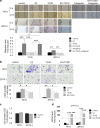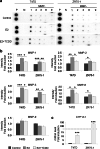Aryl hydrocarbon receptor in breast cancer—a newly defined prognostic marker
- PMID: 24078229
- PMCID: PMC10358065
- DOI: 10.1007/s12672-013-0160-z
Aryl hydrocarbon receptor in breast cancer—a newly defined prognostic marker
Abstract
Aryl hydrocarbon receptor (AhR) has been reported to exert various anticancer effects upon breast carcinoma cells in vitro but its details have remained largely unknown. Therefore, we first examined the AhR status in 90 invasive ductal carcinoma patients using immunohistochemistry. We then performed in vitro studies including wound healing assay, invasion assay, and matrix metalloproteinase (MMP) protein array in order to further elucidate the roles of AhR signaling in breast carcinoma. The status of AhR immunoreactivity was inversely correlated with histological grade (P = 0.0135) and Ki-67 labeling index (LI; P = 0.0087) of the patients. In addition, results of both uni- and multivariate analyses revealed that AhR in carcinoma cells turned out an independent prognostic factor with a protective relative risk (P = 0.0179). An administration of 10 nM 2,3,7,8-tetrachlorodibenzo-p-dioxin (TCDD), a ligand of AhR, significantly decreased Ki-67 LI in an AhR-dependent fashion in MCF-7, T47D, ZR75-1, and MDA-MB-231. Wound healing and invasion assays performed in T47D and ZR75-1 further demonstrated that 10 nM TCDD inhibited estrogen-induced migration and invasion of cells. MMP proteins associated with AhR in breast carcinoma cells were also firstly identified. These results demonstrated that AhR in breast carcinoma cells is considered a newly defined histological prognostic parameter of the breast cancer patients and effects of AhR activation on proliferation and MMPs expression may be related to the relatively good clinical outcome of AhR-positive breast cancer patients.
Figures





Similar articles
-
Activation of aryl hydrocarbon receptor promotes invasion of clear cell renal cell carcinoma and is associated with poor prognosis and cigarette smoke.Int J Cancer. 2015 Jul 15;137(2):299-310. doi: 10.1002/ijc.29398. Epub 2015 Jan 8. Int J Cancer. 2015. PMID: 25523818
-
Activation of the aryl hydrocarbon receptor pathway enhances cancer cell invasion by upregulating the MMP expression and is associated with poor prognosis in upper urinary tract urothelial cancer.Carcinogenesis. 2010 Feb;31(2):287-95. doi: 10.1093/carcin/bgp222. Epub 2009 Sep 15. Carcinogenesis. 2010. PMID: 19755661
-
Aryl hydrocarbon receptor pathway activation enhances gastric cancer cell invasiveness likely through a c-Jun-dependent induction of matrix metalloproteinase-9.BMC Cell Biol. 2009 Apr 16;10:27. doi: 10.1186/1471-2121-10-27. BMC Cell Biol. 2009. PMID: 19371443 Free PMC article.
-
Aryl hydrocarbon receptor induced intratumoral aromatase in breast cancer.Breast Cancer Res Treat. 2017 Feb;161(3):399-407. doi: 10.1007/s10549-016-4063-x. Epub 2016 Nov 30. Breast Cancer Res Treat. 2017. PMID: 27900579
-
Mechanisms of inhibitory aryl hydrocarbon receptor-estrogen receptor crosstalk in human breast cancer cells.J Mammary Gland Biol Neoplasia. 2000 Jul;5(3):295-306. doi: 10.1023/a:1009550912337. J Mammary Gland Biol Neoplasia. 2000. PMID: 14973392 Review.
Cited by
-
Long-Term Exposure of Early-Transformed Human Mammary Cells to Low Doses of Benzo[a]pyrene and/or Bisphenol A Enhances Their Cancerous Phenotype via an AhR/GPR30 Interplay.Front Oncol. 2020 May 29;10:712. doi: 10.3389/fonc.2020.00712. eCollection 2020. Front Oncol. 2020. PMID: 32670863 Free PMC article.
-
Resveratrol and 3,3'-Diindolylmethane Differentially Regulate Aryl Hydrocarbon Receptor and Estrogen Receptor Alpha Activity through Multiple Transcriptomic Targets in MCF-7 Human Breast Cancer Cells.Int J Mol Sci. 2023 Sep 26;24(19):14578. doi: 10.3390/ijms241914578. Int J Mol Sci. 2023. PMID: 37834026 Free PMC article.
-
High AHR expression in breast tumors correlates with expression of genes from several signaling pathways namely inflammation and endogenous tryptophan metabolism.PLoS One. 2018 Jan 10;13(1):e0190619. doi: 10.1371/journal.pone.0190619. eCollection 2018. PLoS One. 2018. PMID: 29320557 Free PMC article.
-
Suppression of global protein synthesis and hepatocellular carcinoma cell growth by Benzimidazoisoquinoline, 4,11-Dichloro-BBQ.Biochem Pharmacol. 2025 Jun;236:116896. doi: 10.1016/j.bcp.2025.116896. Epub 2025 Mar 27. Biochem Pharmacol. 2025. PMID: 40157458
-
Bacterial small molecule metabolites implicated in gastrointestinal cancer development.Nat Rev Microbiol. 2025 Feb;23(2):106-121. doi: 10.1038/s41579-024-01103-4. Epub 2024 Oct 7. Nat Rev Microbiol. 2025. PMID: 39375475 Review.
References
-
- Bertazzi PA, Zocchetti C, Guercilena S, Consonni D, Tironi A, Landi MT, Pesatori AC. Dioxin exposure and cancer risk: a 15-year mortality study after the “Seveso accident”. Epidemiology. 1997;8(6):646–652. - PubMed
MeSH terms
Substances
LinkOut - more resources
Full Text Sources
Other Literature Sources
Medical
Miscellaneous

